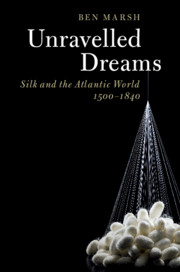1 - Prologue
Published online by Cambridge University Press: 08 October 2020
Summary
The prologue explains how silkworms became an object of fascination in early modern Europe, as their economic and physiological properties began to be more thoroughly understood in areas far distant from the regions in which silk raising (sericulture) originated. It outlines the book’s objective, which is to offer a deep and wide-ranging interrogation of raw silk’s failure as a commodity produced in the Atlantic world. By attending more to historical experimentation and failure, it argues that we can better understand what was distinctive about sericulture and what was particular about the Atlantic world complex: its vast distance, cultural hybridisation, colonial fragility, and manufacturing imbalances. The chapter tracks the global history of sericulture’s spread outward from Neolithic China, synthesising existing scholarship to identify certain prerequisites that accompanied its successful transplantation from one region to another, and variations in systems of production. These included availability of materials, the environmental capacity to accommodate the effective symbiosis of Bombyx mori (silkworms) and Morus (mulberry) trees on which they feed, an adequate seasonal labour pool, and migrant expertise to help establish production and instruct in more complicated processes. It closes by considering the particular opportunities and challenges presented by the Atlantic barrier and oceanic transmission.
Keywords
- Type
- Chapter
- Information
- Unravelled DreamsSilk and the Atlantic World, 1500–1840, pp. 1 - 40Publisher: Cambridge University PressPrint publication year: 2020

